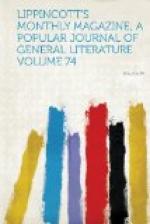Though Dublin is now deserted by the aristocracy, most of the grand-seigneur mansions are still standing. Leinster House, built about 1760, and said to have served as a model for the “White House,” was in 1815 sold by the duke to the Royal Dublin Society. Up to 1868 the duke of Leinster[1] was Ireland’s only duke, and the house is certainly a stately and appropriate ducal residence.
It must, however, be confessed that there is something decidedly triste and severe about this big mansion. A celebrated whilom tenant of it, Lord Edward Fitzgerald, appeared to think so, for in 1791 he writes to his mother, after his return from the bright and sunny atmosphere of America: “I confess Leinster House does not inspire the brightest ideas. By the by, what a melancholy house it is! You can’t conceive how much it appeared so when first we came from Kildare. A country housemaid I brought with me cried for two days, and said she thought that she was in a prison.” It was at Leinster House that “Lord Edward”—he is to this day always thus known by the people of Ireland, who never think it needful to add his surname—after having joined “the United Irishmen,” had interviews with the informer Reynolds, who, it is believed, afterward betrayed him.
Lady Sarah Napier, mother of Sir William Napier, the well-known historian of the Peninsular War, and other eminent sons, was aunt to Lord Edward, being sister of his mother. These ladies were daughters of the duke of Richmond, and Lady Sarah was remarkable as being a lady to whom George III. was passionately attached, and whom, but for the vehement opposition of his mother and her entourage, he would have married. In a journal of this lady’s I find the following interesting account of the search for her nephew: “The separate warrant went by a messenger, attended by the sheriff and a party of soldiers, into Leinster House. The servants ran to Lady Edward, who was ill, and told her. She said directly, ‘There is no help: send them up.’ They asked very civilly for her papers and for Edward’s, and she gave them all. Her apparent distress moved Major O’Kelly to tears, and their whole conduct was proper.”
Lady Edward Fitzgerald (whose husband had served under Lord Moira in America) was at Moira House on the evening of her husband’s arrest. Writing from Castletown, county Kildare, two days after that event, Lady Louisa Connolly, Lord Edward’s aunt, says: “As soon as Edward’s wound was dressed he desired the private secretary at the Castle to write for him to Lady Edward and tell her what had happened. The secretary carried the note himself. Lady E. was at Moira House, and a servant of Lady Mountcashel’s came soon after to forbid Lady Edward’s servants saying anything to her that night.” She continued, after Lord E.’s death, to reside at Moira House till obliged by an order of the privy council to retire to England, where she became the guest of her husband’s uncle, the duke of Richmond.[2]




